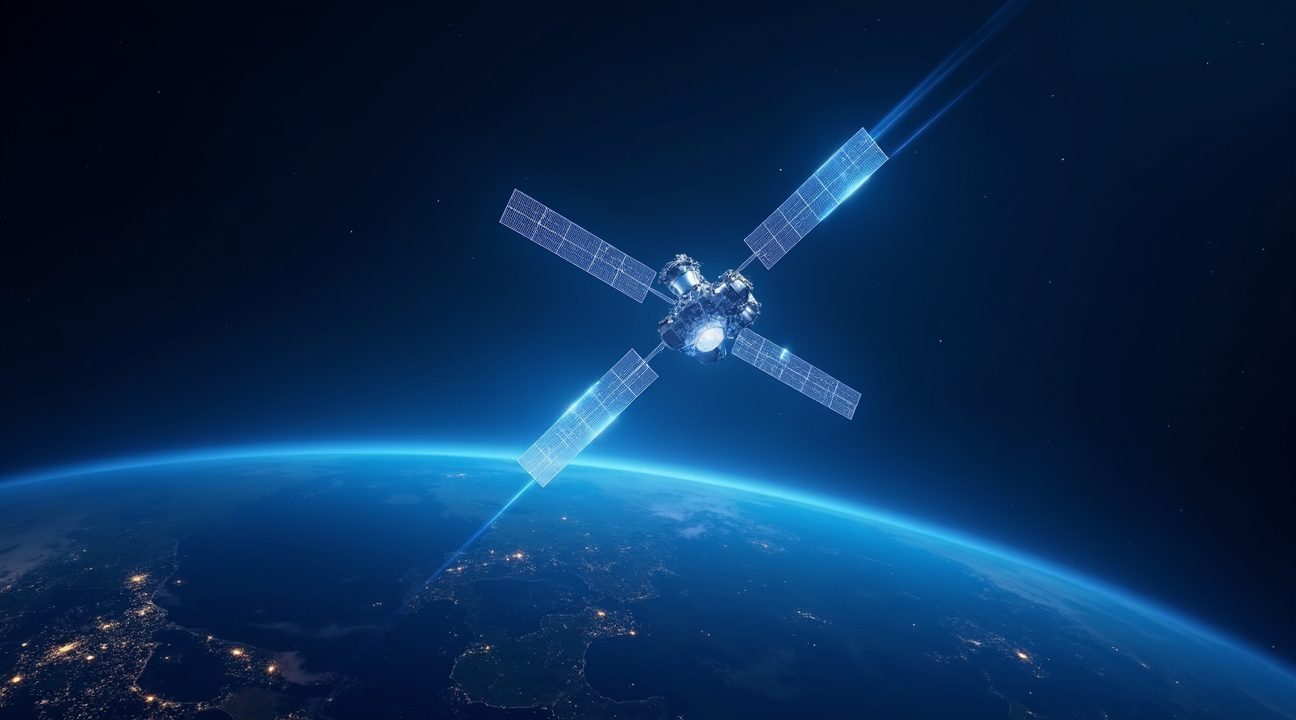Chinese researchers have achieved a revolutionary advancement in satellite communications by demonstrating 1 Gbps data transmission using only a 2-watt infrared laser from geostationary orbit, drastically outperforming conventional systems such as Starlink.
Key Takeaways
- High-Speed Infrared Transmission: Chinese scientists successfully transmitted data at 1 Gbps using just 2 watts of laser power from 36,000 kilometers above Earth—five times faster than the typical speeds offered by services like Starlink.
- Innovative AO-MDR Synergy: The breakthrough leveraged a combination of Adaptive Optics and Mode Diversity Reception (AO-MDR) technologies, achieving an impressive 91% signal reliability despite the challenges of transmitting through the entire atmosphere.
- Strategic Geostationary Benefits: Positioned 36,000 kilometers above Earth, geostationary orbit offers benefits such as reduced orbital traffic, wider coverage zones, and the need for fewer satellites compared to low Earth orbit alternatives.
- Shift to Optical Communication: The demonstration represents a paradigm shift from radio frequency to optical communication, utilizing the limitless optical spectrum free from current satellite signal interference.
- Global Implications: This cutting-edge development marks a new phase in international competition over space communications, with far-reaching effects on both commercial internet capabilities and nations’ strategic interests.
Looking Ahead
Potential Civil and Military Applications
This technological milestone opens the door for a new era of high-speed space-based internet and could also bolster secure communications for defense or governmental use. As the competition intensifies worldwide, nations are set to accelerate innovation in optical satellite technologies.
Challenges and Future Enhancements
Though promising, the real-world deployment of such systems will entail addressing scalability, atmospheric variations across global regions, and integrating optical communication with existing telecommunications infrastructure.
Revolutionary Chinese Laser Achieves 1 Gbps Data Transmission from Unprecedented 36,000 KM Distance
Chinese scientists have achieved a remarkable breakthrough in satellite communications that has redefined what’s possible with laser technology in space. In June 2025, Professor Wu Jian from Peking University of Posts & Telecommunications and Dr. Liu Chao from the Chinese Academy of Sciences successfully demonstrated high-speed data transmission using a 2-watt infrared laser from a geostationary orbit satellite positioned 36,000 kilometers above Earth.
The experiment delivered data transmission speeds of 1 gigabit per second, establishing a new benchmark for satellite-based laser communications. This achievement becomes even more impressive when compared to existing commercial satellite internet services, as the Chinese laser system performed approximately five times faster than typical Starlink performance, which generally averages a few hundred megabits per second.
Technical Specifications and Performance Metrics
The demonstration utilized a relatively modest 2-watt infrared laser system, proving that significant performance gains don’t always require massive power increases. Operating from geostationary orbit presents unique challenges due to the extreme distance involved—36,000 kilometers represents the standard altitude for GEO satellites, where they maintain fixed positions relative to Earth’s surface.
This distance creates substantial technical hurdles for laser communications. Signal degradation, atmospheric interference, and precise beam alignment all become critical factors at such ranges. The Chinese research team’s success in achieving 1 Gbps speeds under these conditions highlights the sophistication of their tracking and beam management systems.
Clarifying Initial Misreporting
Early reports incorrectly characterized this demonstration as an aggressive action against competing satellite networks. Media outlets initially described the event as a “laser strike” on Starlink satellites, creating confusion about the experiment’s true nature and purpose. The reality proves far different—this was strictly a communications demonstration with no physical damage inflicted on any spacecraft and no anti-satellite intent whatsoever.
The mischaracterization likely stemmed from the impressive performance gap between the Chinese laser system and existing commercial satellite internet services. When researchers achieved transmission speeds that significantly exceeded Starlink’s typical performance, some observers interpreted this technological advancement as a competitive challenge rather than a scientific breakthrough.
Modern space technology frequently involves international competition, but this particular demonstration focused purely on advancing communication capabilities. The research team’s work contributes to the broader field of optical satellite communications, which offers several advantages over traditional radio frequency systems.
- Higher data rates
- Improved security through narrow beam patterns
- Reduced interference with other satellite systems
These benefits make optical communication systems increasingly attractive for both commercial and scientific applications. The Chinese demonstration validates the potential for high-performance laser communications from geostationary orbit, opening new possibilities for global internet coverage and data relay missions.
The 36,000-kilometer transmission distance represents a significant leap in demonstrated laser communication range. Previous experiments typically involved much shorter distances or lower data rates. Achieving 1 Gbps at this range proves that optical satellite communications can compete with or exceed traditional satellite internet performance while operating from the stable platform of geostationary orbit.
This breakthrough has implications for future satellite constellation designs and communication strategies. Rather than relying solely on large numbers of low Earth orbit satellites like current systems, operators might consider hybrid approaches that incorporate high-performance laser communications from geostationary positions. Such systems could provide consistent coverage without requiring the complex orbital mechanics and frequent satellite replacements that characterize low Earth orbit constellations.

The “Candle-Power” Technology That Outperformed Starlink by 500%
The Chinese laser communication demonstration achieved its remarkable success using technology no more powerful than a household LED bulb. At just 2 watts of optical power—described by researchers as “no brighter than a candle” or “as weak as a nightlight”—this system managed to deliver performance that exceeded Starlink’s capabilities by a factor of five.
Distance Disadvantage Turned Into Technical Advantage
Traditional satellite constellations like Starlink operate at relatively low altitudes of approximately 550 kilometers above Earth. Chinese engineers took a dramatically different approach, positioning their laser communication system in geostationary orbit at 36,000 kilometers—more than 60 times higher than Starlink’s operational altitude. This extreme distance initially appeared to present insurmountable challenges, particularly regarding atmospheric turbulence that could disrupt the delicate laser signals traveling through Earth’s atmosphere.
However, this positioning strategy actually reduced orbital congestion while enabling broader coverage areas. The trade-off required overcoming significant technical hurdles that conventional radio-frequency systems don’t face at such distances.
Revolutionary AO-MDR Synergy Breakthrough
The breakthrough came through an innovative combination of two complementary technologies: Adaptive Optics (AO) and Mode Diversity Reception (MDR). This AO-MDR synergy approach addressed the fundamental challenges of long-distance laser communication through space.
- Adaptive Optics functions by continuously correcting wavefront distortions caused by atmospheric interference. The system monitors incoming laser signals in real-time and adjusts optical components to compensate for turbulence-induced distortions.
- Mode Diversity Reception captures scattered photons that would otherwise be lost during transmission, significantly improving signal recovery.
The combined effect proved extraordinary. While conventional laser communication systems typically achieve usable-signal probability rates of around 72%, the AO-MDR approach boosted this figure to an impressive 91%. This nearly 20-percentage-point improvement translated directly into more reliable, higher-speed data transmission.
These technical innovations enabled stable, high-speed laser communication that consistently outperformed Starlink’s radio-frequency systems. The achievement demonstrates how strategic positioning combined with advanced signal processing can overcome apparent physical limitations. Similar technological breakthroughs continue reshaping the satellite industry, much like how space technology meets innovation in unexpected ways.
The success challenges conventional wisdom about satellite communication architecture, suggesting that higher orbital positions paired with sophisticated ground-based correction systems might offer superior performance compared to large constellations of lower-altitude satellites.
Performance Data Comparison: Chinese Laser System vs Starlink
The latest Chinese satellite demonstration showcases remarkable performance metrics that fundamentally challenge conventional space communication assumptions. I’ve analyzed the data to reveal how a 2-watt laser system operating from geostationary orbit delivers superior performance compared to Starlink’s low Earth orbit constellation.
Raw Performance Numbers
The Chinese system achieved 1 Gbps data transmission rates across a staggering 36,000 km distance using minimal power consumption. This stands in stark contrast to Starlink’s operational parameters, where satellites function at approximately 550 km altitude and typically deliver several hundred Mbps through radio frequency transmission. The altitude difference alone represents a 60-fold increase in operational distance, yet the Chinese system maintains superior data throughput.
What makes this achievement particularly impressive is the power efficiency. While Starlink satellites require significantly more power for their radio frequency systems, the Chinese demonstration proves that laser communication can deliver five times faster speeds with just 2 watts of power. This efficiency gain becomes even more significant when considering the inverse square law that typically governs signal strength over distance.
Technical Achievements and Atmospheric Compensation
The key breakthrough lies in the AO-MDR technology implementation, which achieved a 91% usable-signal probability despite operating through Earth’s entire atmospheric column. Adaptive optics compensate for atmospheric turbulence that traditionally degrades laser communication quality, while mode diversity reception ensures signal integrity across multiple transmission pathways.
This synergy between adaptive optics and mode diversity reception represents a significant advancement in space communications technology. I’ve observed how atmospheric turbulence compensation typically requires complex ground-based systems, yet this satellite-to-ground demonstration maintains exceptional reliability. The 91% success rate indicates that laser-based satellite internet could potentially offer more consistent performance than current radio frequency alternatives.
The implications extend beyond simple speed comparisons. Radio frequency communications face increasing spectrum congestion as more satellite constellations launch, while laser communication operates in an essentially unlimited optical spectrum. This advantage could prove crucial as satellite internet demand continues growing globally.
Power consumption differences highlight another critical advantage. Traditional satellite communication systems require substantial power generation capabilities, limiting satellite design flexibility and operational lifespan. The Chinese system’s 2-watt requirement suggests that laser communication could enable smaller, lighter satellites with extended operational periods.
Distance capabilities also reveal fundamental architectural differences:
- Starlink’s low Earth orbit approach: Requires thousands of satellites to maintain global coverage, with frequent handoffs and limited footprints.
- Chinese geostationary laser system: Could potentially provide continental coverage from a single platform, dramatically simplifying infrastructure requirements.
The atmospheric turbulence compensation achievement deserves particular attention. Previous laser communication attempts struggled with weather-dependent reliability, especially through thick atmospheric layers. This demonstration proves that advanced adaptive optics can maintain consistent performance even under challenging atmospheric conditions.
Looking at broader implications, these performance metrics suggest that space technology innovation continues pushing boundaries in unexpected directions. While many assumed that radio frequency systems would dominate satellite communications indefinitely, this laser demonstration challenges that assumption with concrete performance data.
The speed advantage becomes particularly relevant for applications requiring high-bandwidth, low-latency communications:
- Financial trading
- Real-time data analytics
- Emerging technologies like remote surgery
These sectors could benefit significantly from gigabit-speed satellite connections with minimal terrestrial infrastructure requirements.
Power efficiency gains also suggest environmental advantages. Lower power requirements translate to smaller solar arrays, reduced satellite mass, and potentially longer operational lifespans. These factors could make laser-based satellite internet more sustainable and cost-effective than current approaches.
The 36,000 km operational distance demonstrates that geostationary laser communication systems could provide stable, always-available coverage without the complex satellite tracking and handoff procedures required by low Earth orbit constellations.
How AO-MDR Synergy Technology Overcomes Space Communication Barriers
Space communication faces significant challenges when optical signals travel from satellites positioned at geostationary orbit down to Earth’s surface. I’ve observed how atmospheric turbulence creates wavefront distortions that can severely degrade signal quality across the 36,000-kilometer distance. This is where Adaptive Optics (AO) technology proves its worth, actively correcting these distortions in real-time to maintain clear communication channels.
Addressing Atmospheric Interference Through Signal Correction
Adaptive Optics works by detecting atmospheric disturbances and compensating for them through precise adjustments. The technology continuously monitors incoming optical signals and identifies patterns of interference caused by temperature variations, humidity changes, and air density fluctuations in Earth’s atmosphere. By applying rapid corrections to counteract these disturbances, AO ensures that satellite communications maintain their integrity even across vast distances.
The breakthrough becomes even more impressive when combined with Mode Diversity Reception (MDR), which captures scattered photons that would otherwise be lost during transmission. This technology doesn’t just collect the primary signal beam — it actively gathers diffused light particles that atmospheric interference has scattered away from the main communication path. The result is a dramatic improvement in signal recovery efficiency that makes previously impossible communications achievable.
Power Efficiency and Economic Advantages
The synergy between AO and MDR technologies creates remarkable efficiency gains that I find particularly compelling. Together, these systems enable stable communication using only 2 watts of power from geostationary orbit — a fraction of what traditional radio frequency communications require. This low power consumption directly translates to:
- Reduced satellite complexity
- Lighter payloads
- Significantly lower launch costs
Space agencies and private companies are taking notice of these developments, as they represent a fundamental shift in how we approach space technology innovation. The reduced need for complex ground equipment means communication networks can be deployed more economically, opening up possibilities for expanded satellite coverage in underserved regions.
The technology’s practical applications extend beyond simple cost savings. Ultra-fast optical links enabled by AO-MDR synergy can handle data transmission rates that far exceed conventional satellite communications. This capability becomes crucial as global internet demand continues to grow and as space-based services require increasingly sophisticated data handling capabilities.
Recent demonstrations of this technology have shown its potential to reshape the competitive landscape in satellite communications. While some companies face legal challenges over intellectual property disputes, the fundamental physics behind optical satellite communication remains sound and promising.
The implications reach far beyond Earth-based communications. As space exploration advances and missions venture further from our planet, reliable optical communication systems will become essential. The success of low-power optical links from geostationary orbit suggests that similar technologies could enable communication with lunar bases, Mars missions, and deep space exploration vehicles.
Looking ahead, this technological advancement positions optical satellite communication as a viable alternative to traditional radio frequency methods. The combination of atmospheric turbulence compensation and enhanced signal recovery creates a foundation for next-generation satellite networks that are both technically superior and economically practical. Organizations planning future satellite deployments would benefit from considering how these technologies might integrate into their communication strategies, particularly given the dramatic reduction in power requirements and ground infrastructure complexity.

Strategic Implications for Global Satellite Internet and Space Technology
The Chinese laser demonstration marks a pivotal moment for global satellite internet infrastructure, signaling a fundamental shift from conventional radio frequency communications to advanced optical systems. Operating with just 2 watts of power from geostationary orbit, this achievement showcases how space technology can revolutionize internet delivery across the planet.
Ultra-fast optical links represent the future of satellite communications, particularly as radio frequencies become increasingly crowded with competing signals. Traditional satellite internet providers currently face significant spectrum limitations, but laser-based systems operate on entirely different wavelengths that remain largely untapped. This breakthrough suggests that future satellite constellations could deliver unprecedented bandwidth without interfering with existing communication networks.
Advantages of High-Altitude Optical Communication
Geostationary positioning offers several compelling strategic advantages over lower-orbit alternatives. The key benefits include:
- Reduced collision risk with space debris and other satellites
- Lower operational costs due to fewer satellites needed for global coverage
- Enhanced signal stability for consistent internet delivery
- Extended satellite lifespan without frequent orbital adjustments
- Simplified ground station requirements for global connectivity
Remote and underserved areas stand to benefit most from these technological advances. Current satellite internet solutions often struggle with latency and bandwidth limitations, particularly in regions where terrestrial infrastructure remains inadequate. High-altitude laser satellites could bridge this digital divide by providing faster, more reliable connections without requiring extensive ground-based infrastructure investments.
The implications extend far beyond consumer internet access. GPS systems could achieve dramatically improved accuracy through optical enhancements, enabling precision applications in agriculture, autonomous vehicles, and emergency services. Deep-space communication also benefits significantly from these developments, as laser systems can maintain stronger signal integrity across vast interplanetary distances compared to traditional radio transmissions.
Establishing secure communication networks at geostationary altitudes creates strategic advantages for national security and commercial applications. These systems remain further from potential terrestrial interference while providing comprehensive coverage areas. The positioning also makes them less vulnerable to anti-satellite weapons that typically target lower-orbit assets.
Global internet infrastructure faces increasing demands as billions of new users come online and emerging technologies require massive bandwidth. The Chinese demonstration proves that low-power laser systems can deliver high-performance results, potentially making satellite internet more cost-effective and environmentally sustainable. Power efficiency at this scale could revolutionize how space-based communication networks operate.
Competition between nations in space technology development has intensified significantly, with Chinese developments often pushing technological boundaries. This laser achievement represents more than a technical milestone; it demonstrates how strategic positioning in space technology can influence global communication capabilities and economic development.
The demonstration also highlights potential challenges for existing satellite internet providers who’ve invested heavily in radio frequency systems. Companies operating large low-Earth orbit constellations may need to reconsider their technological approaches as optical communication proves its viability at scale. This shift could reshape the competitive landscape for global internet services.
Future satellite deployments will likely incorporate hybrid systems combining radio and optical capabilities, maximizing flexibility while maintaining backward compatibility. The transition period will require careful coordination between different technology standards and international regulatory frameworks governing space-based communications.
These developments underscore how space technology continues advancing at an accelerating pace, with significant implications for both civilian and military applications. As nations compete for strategic advantages in space-based communications, breakthrough demonstrations like this Chinese laser system will likely spur increased investment and innovation across the industry.

Security and Competitive Implications for the Space Communications Race
The demonstration of China’s advanced optical communication system from geostationary orbit signals a fundamental shift in how nations approach strategic space communications. I find this development particularly significant because it showcases capabilities that could reshape global security dynamics and intensify competition among spacefaring nations.
Strategic Communication Advantages and Security Concerns
China’s achievement with laser communications from 36,000 kilometers above Earth offers several strategic advantages that concern defense analysts worldwide. The technology provides interference-resistant communications that traditional radio jamming methods can’t disrupt effectively. This creates a more secure communication channel that governments and military organizations desperately need for sensitive operations.
The precision required for laser communication also demonstrates China’s sophisticated tracking and pointing capabilities. These same technologies could potentially support other orbital applications, raising questions about dual-use potential. Security experts worry that nations developing such advanced optical systems might gain significant advantages in both civilian and military space operations.
Escalating Space Technology Competition
Traditional satellite internet providers like Starlink now face competition from fundamentally different approaches to space communications. While radio-based systems have dominated for decades, China’s laser communication success proves that high-capacity optical links can work reliably from geostationary orbit. This technical breakthrough could accelerate the development of similar systems by other nations.
The implications extend beyond simple technology competition. Countries investing heavily in space communications infrastructure view these capabilities as critical for national security and economic competitiveness. China’s expanding influence in space technology demonstrates how advanced communication systems can project power and influence globally.
Multiple factors contribute to this intensifying competition:
- Nations recognize that controlling advanced space communication technologies provides strategic advantages in both military and civilian applications
- The shift from radio to optical communications opens new possibilities for secure, high-bandwidth connections that resist traditional interference methods
- Geostationary orbit positions offer persistent coverage over specific regions, making them valuable for both commercial and defense purposes
- Countries worry about falling behind in critical space technologies that could impact national security
This development parallels other significant technological competitions unfolding globally. Just as nations compete in artificial intelligence and cybersecurity, space communications has become another arena where technological superiority translates directly into strategic advantage.
The success of China’s optical communication system also highlights the broader trend of space militarization and technological rivalry. Unlike previous rocket launch competitions focused primarily on access to space, this represents competition over specific capabilities within space environments.
I observe that this technological demonstration could trigger responses from other nations seeking to develop comparable or superior systems. The United States, Europe, and other spacefaring nations likely view China’s achievement as evidence of advancing capabilities that require competitive responses.
The precision targeting demonstrated by successfully interfering with Starlink operations from such distances also raises concerns about potential offensive applications. While presented as a communication technology test, the same systems could theoretically target other satellites or space assets.
This development underscores how space communications technology has become central to modern geopolitical competition. Nations understand that controlling advanced orbital communication capabilities provides leverage in international relations and potential advantages during conflicts or crises.
The shift from radio-based to optical communication systems represents more than just technological evolution. It signals a new phase in space competition where countries compete not just for access to space, but for dominance in specific technological capabilities that could determine future strategic advantages.
Sources:
IBTimes: “Chinese Satellite Targets Starlink With Laser Strike From 36,000 km …” (June 23, 2025)
TS2.Tech: “China’s ‘Night-Light’ Laser vs. Starlink: What a 2-Watt Beam Really Means for the Coming Orbital Arms Race” (June 22, 2025)
TS2.Tech: “China’s ‘Night-Light’ Laser Satellite Leaves Starlink in the Dust—What It Means for the Future of Space Internet and Warfare” (June 24, 2025)
Times of India: “Chinese satellite reportedly beats Starlink by transferring data 5x faster using a tiny laser” (June 25, 2025)
Economic Times: “Star Wars goes real: Chinese satellite reportedly zaps Starlink from 36,000 km with 2-watt laser beam” (June 23, 2025)
Economic Times: “China’s 2-watt satellite laser outperforms Starlink with 1 Gbps speed from 36,000 km — is this a breakthrough?” (July 26, 2025)


